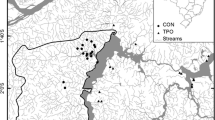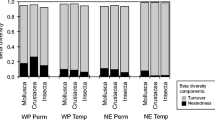Abstract
Measuring biodiversity is difficult. This has led to efforts to seek taxa whose species richness correlates with the species richness of other taxa. Such indicator taxa could then reduce the time and cost of assessing the biodiversity of the more extensive community. The search for species richness correlations has yielded mixed results, however. This may be primarily because of the lack of functional relationships between the taxa studied. Trematode parasites are highly promising bioindicators. Diverse assemblages of larval trematode parasites are easily sampled in intermediate host snails. Through their life cycles these parasites are functionally coupled with the surrounding free-living diversity of vertebrate and invertebrate animals. It has been shown that larval trematodes in snails correlate positively with bird diversity and abundance. Here, we explore whether trematodes also correlate with standard measures of fishes, and large and small benthos, for 32 sites in three wetlands. We found associations between trematodes and benthic communities that were not consistent across wetlands. The associations were, however, consistently positive for large benthic species richness and density. Some of the contrasting associations between trematode and benthos may be explained by negative associations between large and small benthos. We found no associations with fish communities (probably because of the inadequacy of standard “snapshot” sampling methods for highly mobile fishes). The results support further exploration of trematodes as bioindicators of diversity and abundance of animal communities.


Similar content being viewed by others
References
Coan EV, Scott PV, Bernard FR (2000) Bivalve seashells of western North America: marine bivalve mollusks from arctic Alaska to Baja California, 1st edn. Santa Barbara Museum of Natural History, Santa Barbara, CA
Colwell MA, Landrum SL (1993) Nonrandom shorebird distribution and fine-scale variation in prey abundance. Condor 95:94–103
Fredensborg BL, Mouritsen KN, Poulin R (2006) Relating bird host distribution and spatial heterogeneity in trematode infections in an intertidal snail—from small to large scale. Mar Biol 149:275–283
Gardner SL, Campbell ML (1992) Parasites as probes for biodiversity. J Parasitol 78:596–600
Gawlik DE (2002) The effects of prey availability on the numerical response of wading birds. Ecol Monogr 72:329–346
Gunnarsson B, Hake M, Hultengren S (2004) A functional relationship between species richness of spiders and lichens in spruce. Biodivers Conserv 13:685–693
Haldeman SS (1840) A monograph of the Limniades and other freshwater univalve shells of North America. J Dobson, Philadelphia, PA
Hechinger RF, Lafferty KD (2005) Host diversity begets parasite diversity: bird final hosts and trematodes in snail intermediate hosts. Proc R Soc Lond B Biol Sci 272:1059–1066
Hochberg Y (1988) A sharper Bonferroni procedure for multiple tests of significance. Biometrika 75:800–802
Huspeni TC (2000) A molecular genetic analysis of host specificity, continental geography, and recruitment dynamics of a larval trematode in a salt marsh snail. PhD Thesis, University of California, Santa Barbara, CA
Huspeni TC, Hechinger RF, Lafferty KD (2005) Trematode parasites as estuarine indicators: opportunities, applications and comparisons with conventional community approaches. In: Bortone S (ed) Estuarine indicators. CRC Press, Boca Raton, pp 297–314
Huspeni TC, Lafferty KD (2004) Using larval trematodes that parasitize snails to evaluate a salt-marsh restoration project. Ecol Appl 14:795–804
Kati V, Devillers P, Dufrene M, Legakis A, Vokou D, Lebrun P (2004) Testing the value of six taxonomic groups as biodiversity indicators at a local scale. Conserv Biol 18:667–675
Kuris AM (1990) Guild structure of larval trematodes in molluscan hosts: prevalence, dominance and significance of competition. In: Esch GW, Bush AO, Aho JM (eds) Parasite communities: patterns and processes. Chapman and Hall, London, pp 69–100
Kuris AM, Lafferty KD (1994) Community structure: larval trematodes in snail hosts. Annu Rev Ecol Syst 25:189–217
Lafferty KD, Hechinger RF, Shaw JC, Whitney KL, Kuris AM (2006) Food webs and parasites in a salt marsh ecosystem. In: Collinge SK, Ray C (eds) Disease ecology: community structure and pathogen dynamics. Oxford University Press, Oxford, pp 119–134
Lafferty KD, Sammond DT, Kuris AM (1994) Analysis of larval trematode communities. Ecology 75:2275–2285
Lawton JH, Bignell DE, Bolton B, Bloemers GF, Eggleton P, Hammond PM, Hodda M, Holt RD, Larsen TB, Mawdsley NA, Stork NE, Srivastava DS, Watt AD (1998) Biodiversity inventories, indicator taxa and effects of habitat modification in tropical forest. Nature 391:72–76
Loot G, Aldana M, Navarrete SA (2005) Effects of human exclusion on parasitism in intertidal food webs of central Chile. Conserv Biol 19:203–212
Marcogliese DJ, Cone DK (1998) Food webs: a plea for parasites. Trends Ecol Evol 12:320–325
Martin WE (1972) An annotated key to the cercariae that develop in the snail Cerithidea californica. Bull South Calif Acad Sci 71:39–43
McGeoch MA (1998) The selection, testing and application of terrestrial insects as bioindicators. Biol Rev 73:181–201
McIntyre PB, Michel E, France K, Rivers A, Hakizimana P, Cohen AS (2005) Individual- and assemblage-level effects of anthropogenic sedimentation on snails in Lake Tanganyika. Conserv Biol 19:171–181
McLean JH (1978) Marine shells of Southern California, revised edn. Natural History Museum of Los Angeles County, Los Angeles, CA
Miller DJ, Lea RN (1972) Guide to the coastal marine fishes of California. University of California, Oakland
Morris RH, Abbott DP, Haderlie EC (1980) Intertidal invertebrates of California. Stanford University Press, Stanford
Neter J, Kutner MH, Wasserman W, Nachtscheim C (1996) Applied linear regression models, 3rd edn. Irwin, Chicago, IL
Nordby CS, Zedler JB (1991) Responses of fish and macrobenthic assemblages to hydrologic disturbances in Tijuana Estuary and Los Penasquitos Lagoon, California. Estuaries 14:80–93
Olsgard F, Brattegard T, Holthe T (2003) Polychaetes as surrogates for marine biodiversity: lower taxonomic resolution and indicator groups. Biodivers Conserv 12:1033–1049
PERL (1990) A manual for assessing restored and natural coastal wetlands with examples from Southern California. California Sea Grant, La Jolla, CA
Poulin R, Mouritsen KN (2003) Large-scale determinants of trematode infections in intertidal gastropods. Mar Ecol Prog Ser 254:187–198
Quammen ML (1984) Predation by shorebirds, fish, and crabs on invertebrates in intertidal mudflats: an experimental test. Ecology 65:529–537
Quinn GP, Keough MJ (2002) Experimental design and data analysis for biologists. Cambridge University Press, Cambridge, UK
Smith NF (2001) Spatial heterogeneity in recruitment of larval trematodes to snail intermediate hosts. Oecologia 127:115–122
Smith RI, Carlton JT (eds) (1975) Lights’ manual: intertidal invertebrates of the central California coast, 3rd edn. University of California Press, Berkeley
Sokal RR, Rohlf FJ (1981) Biometry, 2nd edn. W. H. Freeman and Company, New York
Sousa WP (1983) Host life history and the effect of parasitic castration on growth a field study of Cerithidea californica (Gastropoda: Prosobranchia) and its trematode parasites. J Exp Mar Biol Ecol 73:273–296
Sousa WP (1990) Spatial scale and the processes structuring a guild of larval trematode parasites. In: Esch GW, Bush AO, Aho JM (eds) Parasite communities: patterns and processes. Chapman & Hall, New York, pp 41–67
Vessby K, Soderstrom B, Glimskar A, Svensson B (2002) Species-richness correlations of six different taxa in Swedish seminatural grasslands. Conserv Biol 16:430–439
Yamaguti S (1975) A synoptical review of life histories of digenetic trematodes of vertebrates with special reference to the morphology of their larval forms. Keigaku Publishing Company, Tokyo
Acknowledgments
We gratefully acknowledge our colleagues in the Pacific Estuarine Ecosystem Indicator Consortium. We thank Shelly Anghera, Stephanie Mutz, and Monique Myers for field work and much of the laboratory processing of the small benthos; Eleca Dunham for laboratory and field assistance; and Leslie Harris for identifying polychaetes. We also appreciate the helpful insight of three anonymous reviewers and the editors. Financial support for this project came from the US Environmental Protection Agency’s Science to Achieve Results (STAR) Estuarine and Great Lakes (EaGLe) program through funding of the Pacific Estuarine Ecosystem Indicator Research (PEEIR) Consortium, US EPA Agreement #R-882867601 and the National Science Foundation through the NIH/NSF Ecology of Infectious Disease Program (DEB-0224565). This work has not been subjected to EPA review and does not, therefore, necessarily reflect the views of the Agency, and no official endorsement should be inferred. RFH received funding from the UC Toxic Substances and Research Program. Our work complied with US Federal and California State law.
Author information
Authors and Affiliations
Corresponding author
Additional information
Communicated by Steven Kohler.
Electronic supplementary material
Rights and permissions
About this article
Cite this article
Hechinger, R.F., Lafferty, K.D., Huspeni, T.C. et al. Can parasites be indicators of free-living diversity? Relationships between species richness and the abundance of larval trematodes and of local benthos and fishes. Oecologia 151, 82–92 (2007). https://doi.org/10.1007/s00442-006-0568-z
Received:
Accepted:
Published:
Issue Date:
DOI: https://doi.org/10.1007/s00442-006-0568-z




